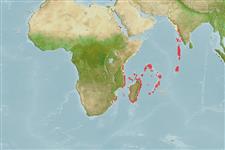>
Gobiiformes (Gobies) >
Gobiidae (Gobies) > Gobiinae
Etymology: Eviota: No etymology given, suggested by Christopher Scharpt: from Latin 'eu' for 'true' and 'iota' for anything very small, in combination 'truly very small' referring to it as being the smallest vertebrate at the time it has benn described by Jenkins (thus, making the suggestion by Scharpt plausible; notata: Named for the large, dark marks on the head and nape (Latin word 'nota' meaning mark).
Environment: milieu / climate zone / rango de profundidad / distribution range
Ecología
marino asociado a arrecife; rango de profundidad 0 - 27 m (Ref. 92021). Tropical
Western Indian Ocean: the Seychelles and Amirante Islands; Mauritius, Mascarene Islands, Cargados Carajos Shoals; and the Chagos Archipelago.
Tamaño / Peso / Age
Madurez: Lm ? range ? - ? cm
Max length : 1.5 cm SL macho / no sexado; (Ref. 92021)
Short description
Claves de identificación | Morfología | Morfometría
Espinas dorsales (total) : 7; Radios blandos dorsales (total) : 6 - 7; Espinas anales: 1; Radios blandos anales: 6 - 7; Vértebra: 26. This species is distinguished from its congeners by the following characters: nape with a series of 3 prominent dark transverse marks, the first 2 of which are separated into enlarged spots dorsolaterally; dorsal to anal fin-ray formula 7/7; complete cephalic sensory pore system; pectoral-fin rays 10-14 always branched; first dorsal fin not elongate (Ref. 92021).
Body shape (shape guide): fusiform / normal.
Life cycle and mating behavior
Madurez | Reproducción | Puesta | Huevos | Fecundidad | Larva
Greenfield, D.W. and S.L. Jewett, 2012. Two new gobiid fishes of the genus Eviota from the Indian Ocean (Teleostei: Gobiidae). Zootaxa 3515:67-74. (Ref. 92021)
IUCN Red List Status (Ref. 130435: Version 2025-1)
Threat to humans
Harmless
Human uses
Herramientas
Special reports
Download XML
Fuentes de Internet
Estimates based on models
Preferred temperature (Referencia
123201): 25 - 28.9, mean 27.4 °C (based on 331 cells).
Phylogenetic diversity index (Referencia
82804): PD
50 = 0.5000 [Uniqueness, from 0.5 = low to 2.0 = high].
Bayesian length-weight: a=0.01023 (0.00477 - 0.02194), b=3.01 (2.83 - 3.19), in cm total length, based on LWR estimates for this (Sub)family-body shape (Ref.
93245).
Nivel trófico (Referencia
69278): 3.0 ±0.3 se; based on size and trophs of closest relatives
Fishing Vulnerability (Ref.
59153): Low vulnerability (10 of 100).
🛈
